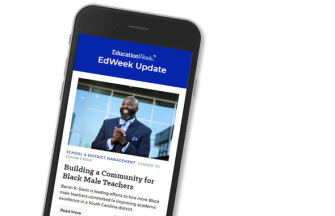Emmanuel Caulk was at a conference for superintendents when he learned that 17 people had died in a school shooting in Parkland, Fla., Feb. 14.
Amidst shock and sadness, the news sparked the same reaction from Caulk, the superintendent of the Fayette County, Ky., district, as it did from all of the administrators at the event: Could this happen in my school?
“The question of whether that could happen here was quickly answered for our community again, and again, and again,” Caulk said.
Two days later, a student left a tip on the district’s anonymous threat-reporting system that a classmate “owns a gun and constantly talks about killing himself/shooting up the school.”
School administrators quickly contacted local police, who entered the student’s home and found an AR-15 rifle and 500 rounds of ammunition. After interviewing other teenagers about the student’s reported threats, the FBI later arrested him on a charge of second-degree “terroristic threatening.”
In the weeks to come, administrators at two high schools in the 42,000-student district would find students carrying loaded handguns—one of which injured the boy who’d smuggled it into a classroom when he accidentally shot himself in the hand.
Both students claimed they had no intent to use the weapons at school.
Now, educators in Fayette County face a challenge districts around the country are confronting: welcoming students back to school in communities that are still trying to regain a sense of safety.
Although statistics show that most schools will never experience a shooting, fear fueled by attacks like those in Parkland and the later one in Santa Fe, Texas, that killed 10 people spills over and affects students around the country.
Even after a summer break, schools continue to face those effects: new mandates crafted by state and local laws, more visible security measures in their buildings, the need to calm concerned parents and students, and a slew of copycat threats that often force precautionary closures and lockdowns.

“What we’re seeing is: ‘I don’t know what you’re gonna do, but you better make these schools safe. Hurry up, you better do it. Now,’ ” said Amy Klinger, the director of programs for the Educators School Safety Network, which consults with schools on safety issues.
Klinger’s organization tracks media reports on school threats, which often don’t lead to an attempted attack. Even before the Parkland shooting, she noticed an uptick in reports at the start of the 2017-18 school year, an increase that dramatically accelerated after that massacre sparked copycat threats, many on social media.
By the end of the year, there were at least 3,378 threats of violence in K-12 schools, the organization found. That’s a 62 percent increase over the previous year’s total.
While some educators may have expected the summer break to create a “cooling off period” that would slow the swell of threats, Klinger said the trend will likely continue in the new school year.
Schools need to have plans to minimize “disruption, fear, and chaos” as they evaluate and respond to threats and other safety concerns, she said.
“If nothing has substantively changed, we’re in for a pretty chaotic school year,” Klinger said.
School Shootings Are Rare
School shootings remain statistically rare, and, contrary to popular perception, school homicides haven’t trended upward in recent years, federal data show.
By many measures, schools have actually gotten safer over time. Rates of student victimization at school—of both violent and nonviolent crimes—have decreased every year in recent decades, federal data show, and children are more likely to be victims of a crime outside a school than inside one.
But those data haven’t stifled public fear about student safety, which is especially high going into the new school year.
About a third of parents responding to a poll commissioned by PDK International said they fear for their child’s safety at school. By comparison, 12 percent of parents responding to the same poll said they feared for their children’s safety at school in 2013, following the shooting at Sandy Hook Elementary School in Newtown, Conn., that left 26 young students and educators dead.
In the same 2018 poll, taken during a period that overlapped with the Santa Fe shooting, just 27 percent said they were “very confident” or “extremely confident” about their school’s ability to deter a gunman.
In that environment, communicating about existing safety efforts may be as important as putting any new measures into place, administrators say.

Like many districts around the country, leaders in Beaufort, S.C., held a “safety summit” last year to explain how the district addresses safety concerns. Administrators will continue to discuss those issues in regular “town hall” meetings, which are held throughout the community in both English and Spanish, district spokesman Jim Foster said.
Within 10 days of the Parkland shooting, local law enforcement investigated six threats to the Beaufort’s schools, all unsubstantiated, Foster said.
And it was clear many parents were afraid. After finding a “vague, nonspecific threat” in an elementary school restroom stall, administrators heightened the police presence to calm anxious families. But that generated its own problems after a woman who saw police vehicles parked outside the school spread rumors of a shooting there on social media, leading to a flood of phone calls.
“You have to react to every report that you get like it’s the real thing,” Foster said.
The district plans some new safety procedures this year, such as requiring all high school students to wear photo IDs, upgrading some aging security cameras, and providing first-aid kits for every classroom that include tourniquets to help stop severe bleeding.
Beaufort also plans three annual lockdown drills, some at inconvenient times, such as lunch or dismissal, so that students are prepared for unpredictable situations. That exceeds a new state mandate of two drills a year, Foster said.
States Take Action
State legislatures have considered at least 261 school safety bills since the Parkland shooting, the National Conference of State Legislatures found. Those proposals most commonly focused on law enforcement, providing additional school safety funding, adjusting laws related to carrying guns in schools, and school police.
The flurry of legislation led to the enactment of 29 bills and six resolutions, including measures that created new ways for students to anonymously report safety concerns, increased penalties for school threats, and assigned task forces to evaluate current safety measures.
That means many schools are scrambling to comply with new mandates as they start the school year. In Florida, for example, some districts struggled to recruit enough police officers and armed guards to meet a new law requiring one in every school.
And some districts are making plans to spend new state and federal dollars channeled to safety efforts.
Klinger of the Educators School Safety Network fears that flood of cash may be too narrowly targeted at high-dollar equipment and the prevention of school shootings. Some of the most important safety measures are well-trained staff, she said, and procedures that ensure schools are as prepared for a natural disaster or a student health emergency as they are for the unlikely event of a shooter.
“There is a perception that if we didn’t have any more school shootings, there would be no more school safety issues, and that’s not true,” Klinger said.
School Safety Plans
The incidents in Fayette County showed that many of the district’s procedures were already working, Superintendent Caulk said. Most importantly, students felt comfortable and safe reporting their concerns about their classmates to adults at school or through the anonymous reporting system.
But the district decided it needed to upgrade some of its equipment and procedures, so Caulk convened a task force of students, teachers, and community members. The group met throughout March to consider such issues as social media, mental-health concerns, and best practices in place in other schools.

A resulting 10-point plan calls for an increase in school law-enforcement and the addition of 37 new mental-health professionals to reduce ratios to no more than 300 students for each psychologist or counselor.
It also calls for metal detectors in middle and high schools, an upgraded emergency-communications system, and a districtwide social-emotional learning program that engages students, staff, and community members.
The school board approved a property-tax increase to pay for the $13.5 million plan, which was set to go into effect if opponents hadn’t collected enough signatures by the Aug. 31 deadline to force a countywide vote on the issue.
There’s always a public response after school shootings in other parts of the country, but this year feels different, Caulk said. Engaging the community broadly in creating a safety plan helped address some of those fears, he said, because community members who attended meetings to provide input also learned about the safety measures the district already has in place.
“It shows that this is top of mind for them, but it’s top of mind for you as well,” Caulk said. “It shows that this is how we problem-solve and how we think through those tough issues.”





